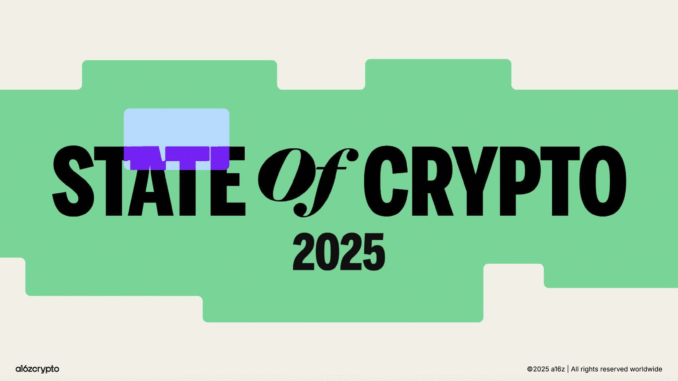
In a landmark analysis released today, Andreessen Horowitz’s (a16z) crypto arm unveiled its “State of Crypto 2025” report, painting a bullish picture of the industry’s maturation amid surging institutional adoption, stablecoin dominance, and a pivotal convergence between artificial intelligence (AI) and blockchain technology. Titled “Stablecoins, Institutional Adoption, and AI,” the report underscores how crypto is evolving from a speculative asset class into foundational infrastructure for the next era of digital innovation.
At the heart of the report’s forward-looking narrative is the intersection of AI and crypto, where blockchains emerge as a counterforce to AI’s centralizing tendencies. “From tracking provenance and IP licensing to providing payment rails for agents, crypto may be the solution for some of AI’s most pressing challenges,” writes Chris Dixon, a16z general partner, in the accompanying thread on X.
The report highlights four key pain points in AI — distinguishing human from machine activity, enabling economic autonomy for AI agents, scaling intellectual property (IP) coordination, and decentralizing compute power — and positions crypto as the ideal toolkit to address them.
The report highlights crypto AI projects like Bittensor, the decentralized machine learning network that’s become synonymous with open, permissionless AI development.
Bittensor embodies the very principles the report champions: a blockchain-based marketplace for intelligence, where miners contribute computational resources and models to a global neural network, earning TAO for their efforts. With ~128 specialized subnets, Bittensor has democratized AI, allowing anyone to participate without relying on Big Tech gatekeepers — like NVIDIA (94% data center GPU market share) or cloud giants Amazon, Microsoft, and Google (63% market share).
Bittensor aligns with the report’s broader thesis: AI’s $80 trillion IP ecosystem and $30 trillion+ in agent-driven economic activity by 2030 will require trustless, verifiable systems that crypto alone can provide.
The timing couldn’t be better for networks like Bittensor. The report notes net stability in the AI-crypto talent pool, with crypto losing around 1,000 jobs to AI since ChatGPT’s launch but gaining from TradFi inflows, fueling hybrid innovation.
As U.S. regulatory tailwinds like the GENIUS and CLARITY bills take hold, Bittensor’s market cap has surged past $5B in 2025, positioning it as a frontrunner in the decentralized intelligence economy.
As Dixon puts it: “Blockchains offer a counterbalance to the apparent centralizing forces of AI systems.” Bittensor, it seems, is ready to run with it.




Be the first to comment